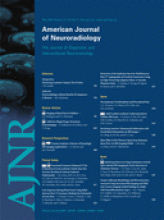Abstract
BACKGROUND AND PURPOSE: Mechanical thrombectomy in ischemic stroke is of increasing interest as it is a promising strategy for fast and efficient recanalization. Several thrombectomy devices have been introduced to the armentarium of mechanical thrombectomy. Currently, new devices are under development and are continuously added to the neurointerventional tool box. Each device advocated so far has a different design and mechanical properties in terms of thrombus-device interaction. Therefore, a systematic evaluation under standardized conditions in vivo of these new devices is needed. The purpose of this study was to evaluate the efficiency, thrombus-device interaction, and potential complications of the novel Phenox CRC for distal mechanical thrombectomy in vivo.
MATERIALS AND METHODS: The device was evaluated in an established animal model in the swine. Recanalization rate, thromboembolic events, vasospasm, and complications were assessed. Radiopaque thrombi (2 cm length) were used for the visualization of thrombus-device interaction during retrieval. The Phenox CRC (4 mm diameter) was assessed in 15 vessel occlusions. For every occlusion a maximum of 3 retrieval attempts were performed.
RESULTS: Complete recanalization (TICI 3/TIMI 3) was achieved in 86.7% of vessel occlusions. In 66.7% (10/15), the first retrieval attempt was successful, and in 20% (3/15), the second attempt led to complete recanalization of the parent artery. In 2 cases (13.3%) thrombus retrieval was not successful (TICI 0/TIMI 0). In 1 case (6.7%) a minor embolic event occurred in a small side branch. No distal thromboembolic event was observed during the study. Thrombus-device interaction illustrated the entrapment of the thrombus by the microfilaments and the proximal cage of the device. No significant thrombus compression was observed. No vessel perforation, dissection, or fracture of the device occurred.
CONCLUSIONS: In this small animal study, the Phenox CRC was a safe and effective device for mechanical thrombectomy. The unique design with a combination of microfilaments and proximal cage reduces thrombus compression with a consequently high recanalization and low complication rate.
Abbreviations
- CRC
- clot retriever cage
- pCR
- Phenox clot retriever
- TICI
- Thrombolysis in Cerebral Infarction
- TIMI
- Thrombolysis in Myocardial Infarction
- Copyright © American Society of Neuroradiology












